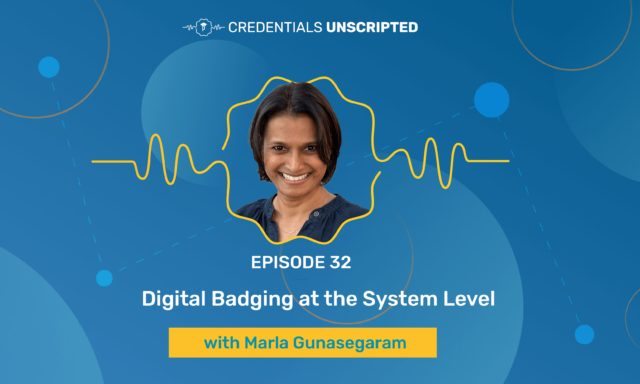
Higher Ed
Digital Badging at the System Level
We use cookies to help you navigate efficiently and perform certain functions. You will find detailed information about all cookies under each consent category below.
The cookies that are categorized as "Necessary" are stored on your browser as they are essential for enabling the basic functionalities of the site. ...
Necessary cookies are required to enable the basic features of this site, such as providing secure log-in or adjusting your consent preferences. These cookies do not store any personally identifiable data.
Functional cookies help perform certain functionalities like sharing the content of the website on social media platforms, collecting feedback, and other third-party features.
Analytical cookies are used to understand how visitors interact with the website. These cookies help provide information on metrics such as the number of visitors, bounce rate, traffic source, etc.
Performance cookies are used to understand and analyze the key performance indexes of the website which helps in delivering a better user experience for the visitors.
Advertisement cookies are used to provide visitors with customized advertisements based on the pages you visited previously and to analyze the effectiveness of the ad campaigns.
Other cookies are those that are being identified and have not been classified into any category as yet.
To mark the 20th anniversary of the Educom NLII Instructional Management Systems (IMS) retreat in March 1997 at Sonoma State University, and the founding of Blackboard LLC in June 1997, Blackboard co-founder and Parchment CEO Matthew Pittinsky shares five observations about the state of eLearning 20 years later. In an earlier blog (Part 1), Matthew shared lessons learned founding and scaling a global education technology platform.
When most (normal) people think of Autumn, their minds turn to Halloween and Thanksgiving. For those of us in higher education technology, however, Autumn means a third annual event is upon us … the annual higher education technology meeting of EDUCAUSE!
This year’s meeting in Philadelphia is a special one, marking the 20th anniversary of one of the most impactful initiatives ever launched by a higher education association. Originally dubbed the Instructional Management Systems (IMS) project, it was the brainchild of visionary leaders Carol Twigg, Bill Graves, and Carl Berger (to name a few) and led by Carol Twigg, Mark Resmer and Steve Griffin.
Their goal? To ensure that a marketplace of learning technologies — learning management systems (LMSs) first and foremost — would emerge to support the delivery of high-quality learning in a networked age. More precisely, a marketplace of standards-based learning technologies. At a time when academic computing played second fiddle to administrative computing, and just three years after the launch of Netscape, the idea that higher education needed to proactively catalyze a learning technology market, while simultaneously ensuring openness and interoperability, was a big and prescient one.
I’ll keep the history brief. While IMS was organized under Educom’s National Learning Infrastructure Initiative a year earlier, it was March 1997 when the project fully kicked-off with a month-long convening. Held on the campus of Sonoma State University, participants from UNC Chapel Hill, Michigan, Maricopa Community College, Penn State, Cal State, Buena Vista University and others, joined with representatives from Apple, IBM, Sun, Thomson Learning and KPMG Consulting (my employer and ticket into the room), to identify the key enabling standards required to support interoperability and reduce friction in the adoption of learning technologies by faculty and institutions. In short, our work was to begin the design of an open architecture for online learning; one that could transform the Internet into a more powerful environment for teaching and learning.
It’s now 20 years later and safe to say the marketplace imagined in 1997 has by and large developed, centered around the widespread adoption of the LMS. IMS was critical to this development. I will leave it to others who work every day with tools and content to judge the degree to which the goal of openness and interoperability has been realized. The IMS project of 1997 has evolved into the IMS Global Learning Consortium, home to such critical standards as LTI and Common Cartridge.
Anniversaries are an opportunity to reflect on time gone by and I’ve been thinking about the state of online learning 20 years later. In various talks on the topic I’ve made five observations that have garnered particularly strong reactions – heated disagreement, as much as support. Here they are:
LMSs provide the 20% of tools that 80% of learning environments need: gradebook, discussion tools, content management, etc. Impactful learning environments are about the 80% of tools that only 20% of learning environments may need because they are specific to that instructional approach and subject. It’s no surprise that the platforms most different from 20 years ago – Minerva, MOOCs, 2U – have all developed in the context of a specific set of programs and with a specific pedagogy.
The rows of the matrix are the four major challenges that characterize the historical development of education in the United States: access, quality, efficiency, equity. As a country and industry, each of these challenges has risen and fallen in relative priority. They are interrelated to be sure. The columns of the matrix are the four major technologies that are being applied to those challenges: networks, interactive media, data, mobile. Some definitions: By “interactive media” I mean the spectrum of learning resources from simulations to augmented reality. We can teach American history by being at the Stonewall Inn in New York City during a seminal moment in the gay rights movement. We can understand the electoral college by simulating marginal shifts in votes by states and see how they change who sits in the White House. By “data” I mean Big Data, but more to the point, the application of Big Data through AI and algorithms, for example in the effort to personalize learning and identify retention risk. When the four big challenges intersect with these four core technologies, the exponential nature of the opportunity space emerges. This is especially true when you consider that the 16 cells of the matrix exist in multiple dimensions, taking on different qualities in the contexts of community college, liberal arts college, the big research university, the HBCU and so on.
| Networks | Interactive Media | Data | Mobile | |
| Access | ||||
| Quality | ||||
| Effecienct | ||||
| Equity |
The original problem Blackboard set out to solve was to augment a traditional classroom-based course with an additional context for learning: the course web site. Discussions and reflections, formative assessments, interactive learning resources, and yes, administrative activities, could all be integrated and enhanced through the LMS. While “hybrid” courses and “flipped” classrooms are a new norm, for many institutions fully online distance learning has overtaken augmentation as their primary strategic focus.
In that context I think it makes sense to ask whether online learning is as good as traditional classroom-centered and campus-based learning. Surveys of employers suggest they don’t believe so, perceiving online degrees lower in terms of quality. Of course it’s foolish to judge all subjects, degree programs, education providers and learners with a single pronouncement. It’s foolish to make the statement that online education is not as good when there are examples of programs or providers that no doubt are better.
That said, I think we are way too uncritical in our acceptance of online education as a delivery method. We should ask the question, Are online learning environments as good as high impact brick-and-mortar environments? For me the answer is usually no, with only a few exceptions. I say this for three interrelated reasons. First, I believe that nearly all instruction delivered by a college or university should embed in its design the principles of a liberal arts education. As Michael Roth, president of Wesleyan University and closing keynote at our latest Parchment Summit, argues, a liberal arts education is at its core about producing leaders and change agents with the capacity for innovation, judgement and productive risk taking. Second, I believe that education is fundamentally a social process rooted in experience: instructor-to-student, student-to-student, in the context of instructor-led activities and outside of them. Few online learning environments are social at their core, and the answer is not borrowing from the design principles of Facebook! Third, I believe in the unofficial curriculum of a campus-based undergraduate education (and many graduate programs as well). Learning is what happens in the quad, library, residence halls, student groups, lectures, faculty office hours, research projects … the list goes on. Most online programs reflect a fraction of that richness. Student life is higher education’s secret sauce.
Usually these observations generate three objections. The first two are that there are institutions that prove me wrong, and there are instructional programs for which my objections are not as relevant. Both are true. The third objection is that I fail to acknowledge the barriers to access that are being broken down with online. The typical learner is not 18-21 and living on campus. Students can earn degrees who might not otherwise. And online can be delivered at a cost that can expand attainment.
Here I stand my ground. I believe that the goal of broad attainment of higher education is about more than just individual economic mobility. I believe that the liberal arts principles and unofficial curriculum that characterize brick-and-mortar higher education (done well) are critical to both economic mobility and the broader purposes of a degree. I also believe that historically our education system has proven to be remarkably good at sorting students by race and class in ways that perpetuate inequality. We must be on guard and bring a critical eye. There is a real risk that the sorting of who learns through online education and who learns on campus will become the 21st century postsecondary equivalent of the 20th century practice of tracking by secondary schools, which was not a happy story.
My point is that big change does happen in higher education. It just takes longer and it happens incrementally. That is, A leads to B, B to C and C to D. Rarely does A lead directly to D. This “radical incrementalist” model is the secret to technology-driven innovation in the academic world.
There you have it. Twenty years have gone by. We must be humble and recognize the true state of what online education can do pedagogically. There’s a temptation to believe the medium can do more than it can, especially with the siren song of disruption calling out to do more, faster. We have experience now upon which to draw. Companies like Blackboard are reimagining the LMS with the benefit of rich data about how people teach and learn.
The vision of IMS was interoperable tools and content, accessible by faculty to support their instruction and student learning. It is a vision as urgent and important today as in 1997. See you at the Parchment booth at Educause!
